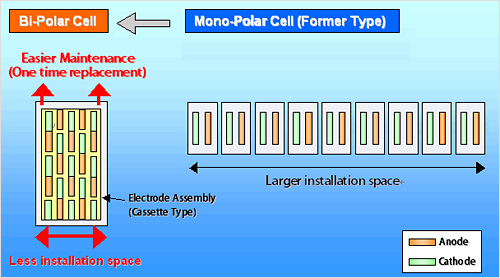Electrochlorination System (MENES) : Technologies
Distributors :
Principle of System
Seawater normally contains chlorine ion (Cl-) at a concentration of from 15,000 to 20,000ppm. By electrolysis of seawater, the following reactions occur:
At anode: 2Cl- → Cl2+2e
At cathode: 2H2O+2e → 2CH-+H2
2Na++2CH- → 2NaCH
Free chlorine (Cl2) generated at the anode reacts with caustic soda (NaOH) generated at the cathode and forms sodium hypochlorite solution (NaClO).
Cl2+2NaCH → NaClO+NaCl+H2O
Injection of sodium hypochlorite solution is very effective to avoid accumulation of marine life like shellfish and seaweed etc.

Bi-polar Cell
Bi-polar cell unit was developed in 1982 and are now our standard design. The electrode plate in the Bi-polar cell unit has two parts. The lower half part of plate coated with platinum metals working as anode and the upper half part with titanium surface (no coating) working as cathode. The electrodes are positioned every other plate by only half plate.
Comparing with Mono-polar cell (former type cell), this Bi-polar cell can achieve;
- Less Installation Space
- Easier Maintenance (because all electrode plates are assembled and can be replaced one time)
- Higher Efficiency

MITSUBISHI Recycle System
MITSUBISHI Recycle System is our particular technologies which was developed in 1982. As shown in the typical system flow of MITSUBISHI Recycle System, sodium hypochlorite solution produced in the Bi-polar cell unit is transported to the cell unit again with seawater, while some portion of it is discharged into the seawater inlet channel.

Advantages of MITSUBISHI Recycle System
MITSUBISHI Recycle System is scale adhesion free system because its Seeds Effect. Therefore, comparing to Once-Through System, MITSUBISHI Recycle system can reduce a frequency of acid cleaning work dramatically from once per month (12 times per year) into once per year (1time per year).
As the result MITSUBISHI Recycle System can achieve
- Stable operation without scale adhesion problem
- Easier maintenance and lower maintenance cost with less acid cleaning frequency
- Minimum environmental load with less acid waste


